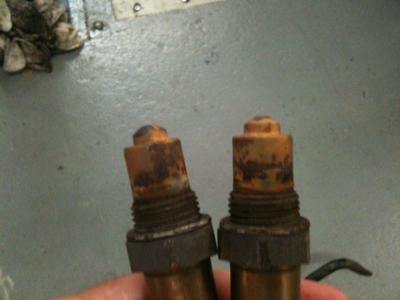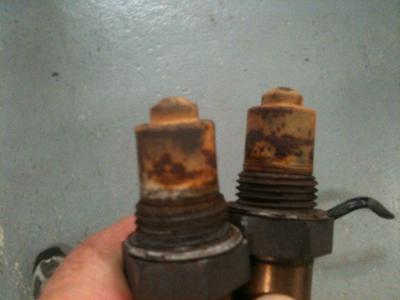During the run up to the Mojave Mile and Texas Mile, we started adding some VP Racing Q16 leaded race gasoline to boost our performance. Between Mojave and Texas, we switched to 100% Q16 and retuned the car for it. Q16 seemed like a logical choice because it's very high octane, leaded, and oxygenated -- just what we need for the moisture-rich Texas weather. I figured, I'm catless -- so what's the problem? ZZZZZZZZZt. WRONG ANSWER.
When ESS tuned to car, they sounded the alarm and said they didn't think Q16 was a good idea. But it was my call, and I chose to stick with the Q16 for Texas. As some of you know, our Texas Mile runs abruptly ended on the first (of three) days of competition when "something" happened. (Texas Mile details were posted HERE.) All we knew was the RPMs went way down in 3rd-6th gears. At first our RPMs were down to 7000, then 6500, and eventually the car didn't rev past 6000 RPMs. We knew the motor was fine -- because it ran fine in 1st and 2nd gears -- but we didn't know what was causing 3rd-6th gears to act like the motor developed a misfire.
I believed we fouled our O2 sensors -- but others disagreed. The VP Racing representative happened to come by when we were working on the car -- and he too opined that we fouled our O2 sensors. Yet others believed we fouled the plugs. One thing we all seemed to agree upon: the source of the problem was the Q16 race gas.
We gambled that we could simply change the gasoline from Q16 to MS109 and the problems would go away. It was a gamble that didn't pay off. After changing the gas, the "misfire" still occurred. To diagnose the problem, I attached the BT tool, read the codes -- and it was blank -- not a single code in the DME. All misfires store codes in the DME, but fouled O2 sensors do not. By this time it was too late to travel to Houston to pick up a pair of O2 sensors -- so our venture at the Texas Mile was over on the first day.
To be safe, we changed the plugs and O2 sensors. When we pulled out the O2 sensors -- a look of horror came across eveybody's face...when this is what they saw:

Clearly, we screwed up the O2 sensors. But we're not out of the woods yet. We
started driving the car -- and found out the problem didn't go away -- in fact
it's now worse! Now the "fouling" is down to 6000 RPMs -- and it's happening in
2nd gear as well! But on the good side, the ESS guys have been looking into this
and made some interesting discoveries.
AJ @ ESS looked into the DME code and discovered that the ECU constantly
sanity checks the O2 sensors. If the DME sees something it doesn't like in a
certain gear, it "installs" an RPM limiter. If the problem persists, then the
RPM limiter gets lower and lower. This is exactly what was happening to us. As
we continued to drive the car with the Q16, the RPM limiter kept getting lower
and lower -- because we had fouled the O2 sensors. There's only two ways to fix
it (assuming you've replaced the O2 sensors): 1) clear the adaptations in the
DME; 2) drive it out. Since we had no way to clear the adaptations ourselves, we
had to do the latter -- drive it out.
The DME goes through an adaptation cycle about every 50 miles. So after
replacing the O2 sensors, about every 50 miles our rev limiter would increase
another 500 RPMs. After 200 miles, the car was back to normal.
It was a hard lesson to learn. As we've seen others running C16 without "any"
problems, we figured running an oxygenated version of the same fuel wouldn't be
such a bad thing. We were sorely mistaken. In fact, in Texas, the racing team
servicing the 250 MPH Ford GT told us that Q16 is so nasty, they literally
change the plugs after every run and then tow the car out to the starting line
-- just so the car doesn't idle with Q16.
So how much gas did it take to screw up my O2 sensors that bad? How many
tankfuls did it take? It was much less than you think: it only took about 15
gallons to screw it up that badly. So think twice before using C16, Q16, or any
other leaded race gas in your S65 motor. Within a short amount of time, you can
foul your O2 sensors and ruin your performance.


